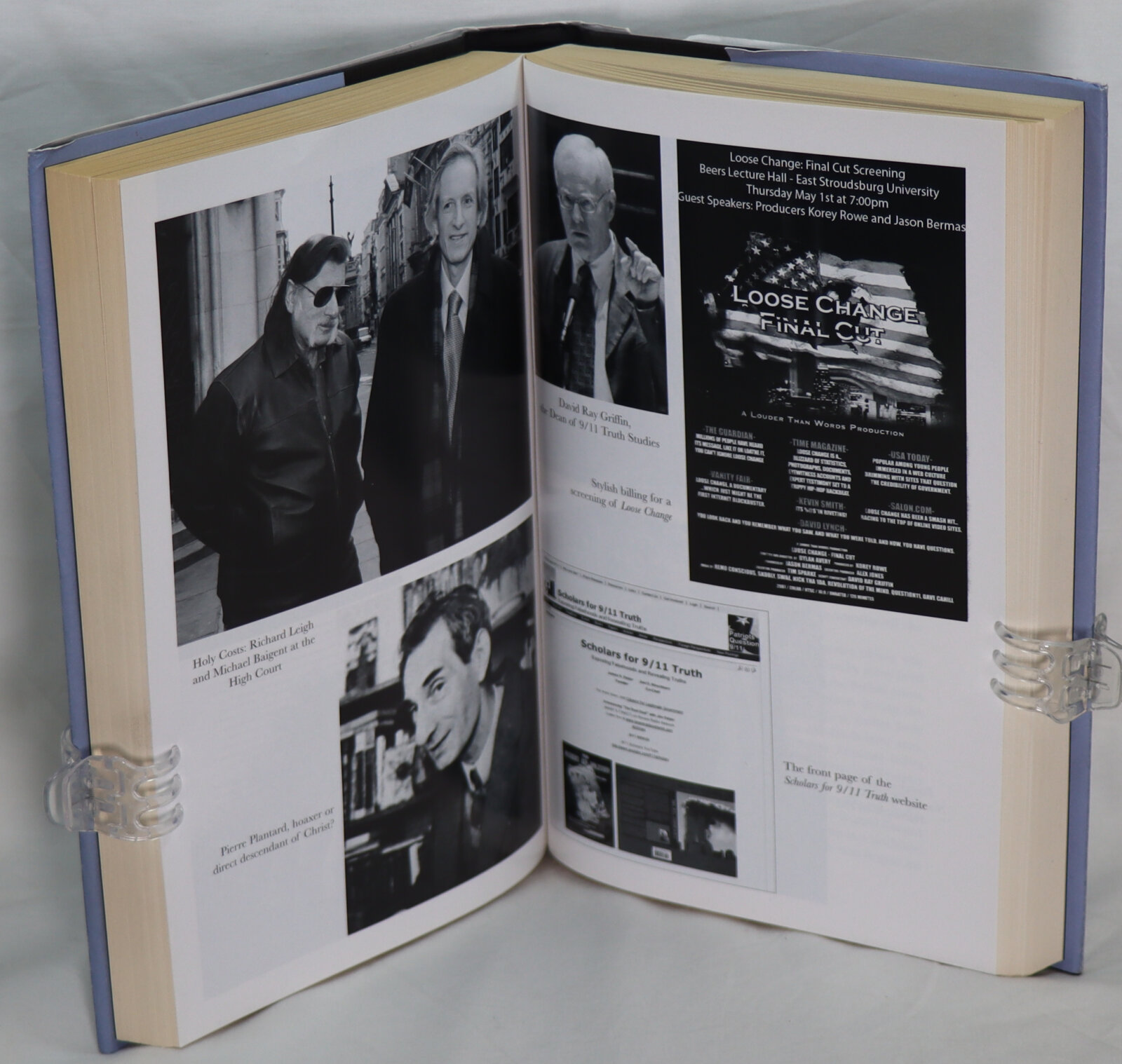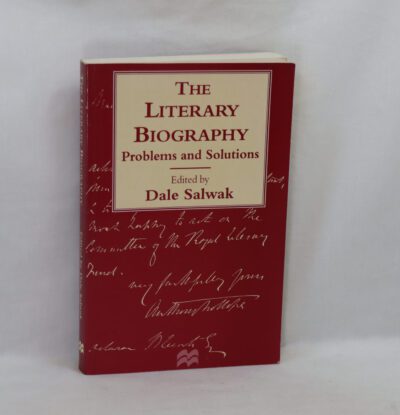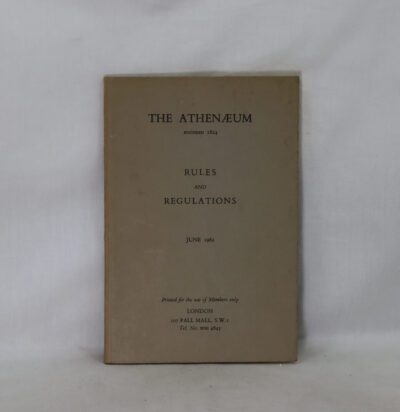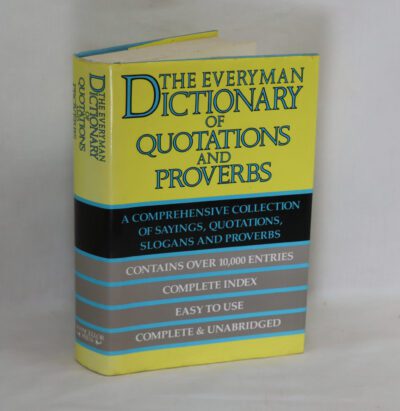Voodoo Stories.
By David Aaronovitch
ISBN: 9781101185216
Printed: 2009
Publisher: Jonathan Cape. London
| Dimensions | 17 × 24 × 4 cm |
|---|---|
| Language |
Language: English
Size (cminches): 17 x 24 x 4
Condition: Fine (See explanation of ratings)
Your items
Item information
Description
In the original dustsheet. Black cloth binding with silver title on the spine.
-
F.B.A. provides an in-depth photographic presentation of this item to stimulate your feeling and touch. More traditional book descriptions are immediately available.
Our age is obsessed with the idea of conspiracy. We see it everywhere – from Pearl Harbour to 9/11, from the assassination of Kennedy to the death of Diana. Bookshop shelves threaten to collapse under the weight of texts devoted to proving myriad conspiracy theories true, while even quality newspapers and serious TV channels are prepared to give them credence. For David Aaronovitch, there came a time when he started to see a pattern. These theories used similar dodgy methods with which to insinuate their claims: they linked themselves to the supposed conspiracies of the past (it happened then so it can happen now); they carefully manipulated their evidence to hide its holes; they relied on the authority of dubious academic sources. Most importantly, they elevated their believers to membership of an elite – a group of people able to see beyond lies to a higher reality. But why believe something that entails stretching the bounds of probability so far? Surely it is more likely that men did actually land on the moon in 1969 than that thousands of people were enlisted to fabricate a deception that they did. In this entertaining and enlightening book – aimed to provide ammunition for those who have found themselves at the wrong end of a conversation about moon landings or twin towers – Aaronovitch carefully probes and explodes a dozen of the major conspiracy theories. In doing so, he looks at why people believe them, and makes an argument for a true scepticism: one based on a thorough knowledge of history and a strong dose of common sense.
Reviews:
-
If you had to sum up postmodernism in one word, I think a strong (but by no means only) contender would be the word SUSPICION. Suspicion of power, suspicion of motives, suspicion of truth claims – in short, suspicion of absolutely everything and everyone. And of course what is one insidious but pervasive manifestation of suspicion? The Conspiracy Theory. The twentieth century seems to have bred such theorists – they’re everywhere. And they have their audience over a barrel – if you question or disagree with them, you’re just a patsy, gullible putty in the oppressors’ hands. Then if you present a substantial case against them, well, you can hear the lines already: – `aah, but there’s no smoke without fire…’ (that cowardly retort of the gossip); – `hey, I’m just asking questions’ (when of course, they’re doing no such thing);- `but what about Watergate?’ Well yes, that was a conspiracy, and yes, politicians are often corrupt. But think about it. Watergate was such a grubby and unambitious conspiracy (i.e. covering up the business of eavesdropping on political opponents) compared to the more extreme theories people tenaciously hold to. And they are often extreme and extraordinarily ambitious. If true, many of these would need not just scores but hundreds and even thousands of accomplices (unwitting or otherwise) – who ALL keep quiet (by force or voluntarily). Just glancing down the list of conspiracies tackled by the journalist David Aaronovitch in his recent book, Voodoo Histories, makes clear how ambitious some of these are: – Protocols of the Elders of Zion – a Jewish conspiracy to take over the world (now clearly proven to be a fraud – and yet scarily, still touted in Islamist circles as a justification of their opposition to Israel’s existence) – Stalin’s purge of Trotskyites incl Pyatakov in 1937 – President Roosevelt knew (and even wanted) Pearl Harbor – even people like Gore Vidal subscribe to this view – Senator McCarthy’s suspicions of communists in government – The ‘mysterious?’ deaths of popular `deities’: JFK, RFK, Marilyn Monroe, Princess Diana – Doubting whether or not the moon landings ever took place – The ‘mysterious?’ death of Hilda Murrell & nuclear conspiracies in the 1980s (a conspiracy championed by the otherwise redoubtable Tam Dalyell MP) – Baigent, Leigh and Lincoln’s thesis about the descendents of Jesus in Holy Blood and Holy Grail, as picked up by Dan Brown and the Da Vinci Code – Erich Von Daniken’s theories and books Chariots of the Gods? Was God an Astronaut? – 9/11 & 7/7 conspiracies – from the “let it happen on purpose” (LIHOP) types to the “made-it-happen-on-purpose” (MIHOP) types. – David Kelly’s suicide after his Commons Select committee testimony about Iraqi weapons evidence – The ‘birthers’ who doubted Obama’s birth certificate & rumours of the Clinton “body count”. That’s an extraordinary, comprehensive list – and these are just some of the most prominent ones (go online and you’ll find a conspiracy theory to suit every conceivable taste and obsession). This book is a fascinating but chilling read. Some theories are very popular – and even regarded as de rigeur if you don’t want to look a fool (e.g. JFK was shot by two shooters at least. Wasn’t he?). Aaronovitch is clearly a sceptic. But his research methods and approach seem impeccable, logical and at times exhaustive. He presents a convincing case at many points. He produces clear evidence to prove their idiocy, even if it has appeared long after their fashions has waned. There is so much common sense here – that it is a book worth lending to any with conspiracist inclinations.
THE CATHOLIC COVER-UP AT RENNES-LE-CHATEAU? Bizarrely enough, one of his most compelling chapters (I’d not anticipated this at all as I’d not even noticed its inclusion when I picked the book up), was his merciless dismantling of the ludicrous theories behind Dan Brown’s Da Vinci Code. Many Christian apologists have done a great job at approaching the evidence from an ancient historical perspective. What was so compelling here was his observations of the evolution of this particular narrative: a nineteenth century catholic parish priest who mysteriously becomes rich. This clearly means that was paid off by Rome to keep schtum about what he’d uncovered – i.e. the genealogical line of Jesus & Mary Magdalene. Well Aaronovitch shows that this whole business bears many of the hallmarks of other conspiracy theories. What is not often appreciated (I certainly hadn’t realise this) is that practically ALL the main perpetrators in France of the Merovingian mythology have since admitted that the whole thing is a hoax. Here’s a flavour of Aaronovitch’s style (himself from a Jewish Marxist background with certainly no axe to grind in favour of Christianity): “The playful Henry Lincoln [one of the co-authors of Holy Blood & Holy Grail] has also been fond of using the partiality and contradictory nature of New Testament interpretations to sanction his own liberties. Is it more likely, he asks, that a man should have been born of a virgin, been able to walk on water and rise from the dead than that he should have been born as other men are born, married, and raise a family? It’s a good line, but the trouble is that while the Gospels do create some evidence for a man called Jesus who led a religious movement in the early years of the Roman empire, there is no evidence whatsoever from any source at all for that man being married or having children. None.” (pp199-200) This is how he sums up the chapter – the main protagonist, Pierre Plantard, being the centre of the story’s attention as the one claimed to be a descendent of Jesus Christ himself. “It was all a hoax, every bit of it. It began with a story, which then developed into a massive fantasy, support for which was manufactured by forging documents. Many of these were lists of names copied from other genealogists and registers, and then tinkered with; others were invented travelogs. The motives of the participants are varied. De Cherisey was interested in surrealism and in the 1960s was involved in an organisation called the Workshop for Potential Literature (Oulipo), in which the members played around with puzzles, ciphers and codes. Plantard, as we have seen, had been trying most of his life to give himself some significance through shadowy or secret organisations, joining the many people through the centuries who have been attracted to the idea of membership of a clandestine society with elite, and sometimes occult, powers to organise the world. Finally, there were those motivated simply by money. (p204)”
CUI BONO? There are some great lines. In a previous section, referring to Princess Diana’s death in a Parisian tunnel, he refers to the theories put forth by some ex-MI5 agents, and draws in a magnificent line from Umberto Eco’s breathtaking Foucault’s Pendulum .”Studying the competing claims of various secret sources, one can see that to believe one is to disbelieve the others. Whether the authors who used these sources were complicit in what must, at the very least, have been a series of hoaxes is impossible to say. But if one were to ask the old conspiracist question Cui bono? (Who benefits?), the answer seems obvious. I say ‘seems’ because in this world every debunkable theory could in fact be disinformation put out by the Establishment/security services to throw investigators and the public off the scent. Such a hypothesis was put forward by former MI5 officer Annie Machon on Channel 4’s Richard and Judy in 2005. It was the very stupidity of some of the theories surrounding Diana’s death, she told her interviewers, that first convinced her that the accident was in fact murder. She had been alerted to the conspiracy by the classic MI6 disinformation technique of suggesting conspiracies. Or, as Umberto Eco put it, “The Rosicrucians were everywhere, aided by the fact that they didn’t exist.”” (p150) Or take this, about the death in the 1980s (subsequently proven to be the result of a break-in gone horribly wrong) of Hilda Murrill a known anti-nuclear activist. This was taken up as a cause by the famous Labour Old Etonian MP, Tam Dalyell. “While the notion of members of the British security services going around bumping off little old ladies in English market towns (more or less the exact opposite of their official role) may have amazed most MPs, it simply angered Mr Dalyell.” (p175) And I like this idea of an ‘equal-opportunity conspiracist’, in his analysis of Gore Vidal’s various political theories! “Vidal, like Philip J Berg, was an equal-opportunity conspiracist, and was comfortable whether accusing FDR, Harry Truman, LBJ, Bill Clinton or George W. Bush, of complex and dastardly secret acts for various nefarious purposes – usually as pretexts for war or domestic crackdowns.” (p303)
CONSPIRACY COMMONALITIES: So what do these theories have in common?
Well, in drawing various threads together, 4 features particularly struck me:
(i) A history for losers and the disempowered. As Aaronovitch observes: “There is a more than plausible argument to be made that, very often, conspiracy theories take root among the casualties of political, social or economic change.” (p326) You can certainly see this in the American political scene, where accusations of all kinds of dastardly plots are leveled against the White House from the left (if it has a Republican incumbent) and from the right (if it has a Democrat). There’s a type of comfort, a moral high ground even, in the notion of being beaten by skulduggery (rather than having to admit that your policies or candidates were rubbish).
(ii) An ironic credulity
Conspiracists accuse those who believe official statements or explanations or reports as being gullible. And as said at the start, there are often good grounds for believing in the corruptibility of those in power. After all, that’s precisely what lay behind the American constitutional system of checks and balances. But the conspiracies believed are so extraordinary, so over the top and involving so many different people, that to believe them is more incredible. As Aaronovitch points out, people seem quicker to believe the almost ridiculous than to accept the (often tragic but) simplest explanation (as applying Occam’s razor might suggest). (p253)
But this credulity is perhaps motivated by something else, something deeper, and this is what really struck a chord with me…
(iii) A desire for proper ending – a story that improves on reality
Conspiracy theories provide a means of avoiding the occasionally irrational and meaninglessness of human existence. We yearn for our lives to be part of a narrative. We long for the tragic to have a purpose. A conspiracy theory provides just such a narrative. Aaronovitch quotes from one Sarah Churchwell about Marilyn Monroe’s death: `it is only narrative that promises a reason for early death; reality offers no such assurance’ (p161).
“The American playwright and screenwriter [David Mamet]’s fourth collection of essays almost starts with the words, `It is in our nature to dramatize’. By this Mamet doesn’t mean that we are a bit histrionic sometimes, but rather that we need to construct, or have constructed, dramas and stories for ourselves. Their patients, like the rest of us, invariably have a story about inexplicable or mundane aspects of our lives. Our illnesses are due to stress or genetics or that day we went out for a walk and it was cold. Adopted children very often create a backstory of their real parents, and unadopted children have fantasies of their `real’ mothers and fathers. As Mamet points out, we will ahve a story even if it means giving characteristics to the elemental. So `the weather is impersonal, and we both understand it and exploit it as dramatic, i.e. having a plot, in order to understand its meaning for the hero, which is to say, for ourselves.'” (p339)
Bad things happen – it’s a fact of life. Conspiracy theories somehow make them easier to accept. They provide someone to blame.
“A New York fire chief asked to account for the various theories surrounding the collapse of buildings at the World Trade Center attributed them to the disappointment of people’s belief in the omnipotence of the emergency services. `In the movies,’ he said, `it’s always wrapped up in the end.’ Or as Norman Cohn puts it when discussing paranoid thought in his history of apocalyptic movements, people cannot accept `the ineluctable and imperfections of human existence, such as transience, dissension, conflict, fallibility whether intellectual or moral.'” (p341)
(iv) Suspicion is fair enough – but such power is a delusion
Scepticism is a healthy means for discovering truth. But scepticism can turn back in on itself, so that people cease to be sceptical about the things they’re sceptical about! They believe that human power is far greater than it really is – and see conspiracies everywhere. Whereas in reality, human beings are nothing like as omnipotent as we like to admit (as the New York fire chief knows all too well). But this suspicion is the epitome of postmodernism. Lyotard defined it as ‘an incredulity towards all metanarratives’; the conspiracist extends that to an incredulity to all official explanations as well! And as Aaronovitch observes:
“This is an approach that dovetails with an intellectual trend that has become increasingly attractive to academics and intellectuals in recent years. Loosely labelled postmodernist, or post-structuralist, one aspect of this inclination is a distrust of normative notions of truth. `You show me your reality,’ it suggests, `and I’ll show you mine.’ All accounts of events are essentially stories, and no single account ought to be privileged above another. It is a seductive and not entirely worthless way of looking at the world.” (p331)
But it’s not entirely liveable nor real either. And ironically enough, it doesn’t stop the conspiracist holding to their theory as nothing less than the gospel truth.
All in all, this is a brilliant book. Gripping, intelligent, persuasive. It actually faces up to truth and reality in a much more honest and uncomfortable way than many conspiracists ever do. So when someone next spouts out some conspiracy theory about this that or the other, you never know. It might lead to a discussion of much bigger things…
-
The first part of this book was really enjoyable – a pretty detailed look at the anti-Semitic conspiracy Protocols, a fascinating account of the anti-Trotsky faction trials in Russia, some in-depth insight into Mccarthyism and its origins….. then it goes somewhat downhill. The JFK/Marilyn Monroe stuff, fair enough, but to have an entire chapter devoted to the death of Hilda Murrell? How does this conspiracy in any way “shape modern history”? It’s passed largely into obscurity. A chapter on the associated Da Vinci code conspiracies? It’s just shooting not very interesting or important fish in a barrel. The chapter on 9-11 conspiracies would probably be of interest to people who haven’t previously read of this in detail (though i expect many have). Ditto the Diana conspiracies – but i can’t believe there are many people left in Britain not already sick to death of that one….It’s frustrating because the book never really delivers what it promises – evidence of how conspiracies have actually shaped modern history. And yet with less of a British focus there was some fantastic source material to be used – the Russian apartment bombings used as the pretext for the Chechen war. They warrant a genuinely interesting discussion of the facts. Ditto the poisoning of Litvinyenko or the poisoning of Viktor Yushchenko. Or the “HIV does not cause AIDS” conspiracy and associated beliefs that it was all a western imperialist conspracy. This led to SA president Mbeki dismissing the use of retro-virals and to the unnecessary deaths of tens (if not hundreds) of thousands. Or keeping with the British theme, a discussion on Lockerbie, probably the most interesting British conspiracy (in terms of political intrigue) of the last few decades. All in all I couldn’t help thinking that this was a missed opportunity to create something special. I’ve given the book 4 stars because I did enjoy it, but it could have been an exceptional book given the source material available.
David Morris Aaronovitch (born 8 July 1954) is an English journalist, television presenter and author. He is a regular columnist for The Times and the author of Paddling to Jerusalem: An Aquatic Tour of Our Small Country (2000), Voodoo Histories: the role of Conspiracy Theory in Modern History (2009) and Party Animals: My Family and Other Communists (2016). He won the Orwell Prize for political journalism in 2001, and the What the Papers Say “Columnist of the Year” award for 2003. He previously wrote for The Independent and The Guardian.
Want to know more about this item?
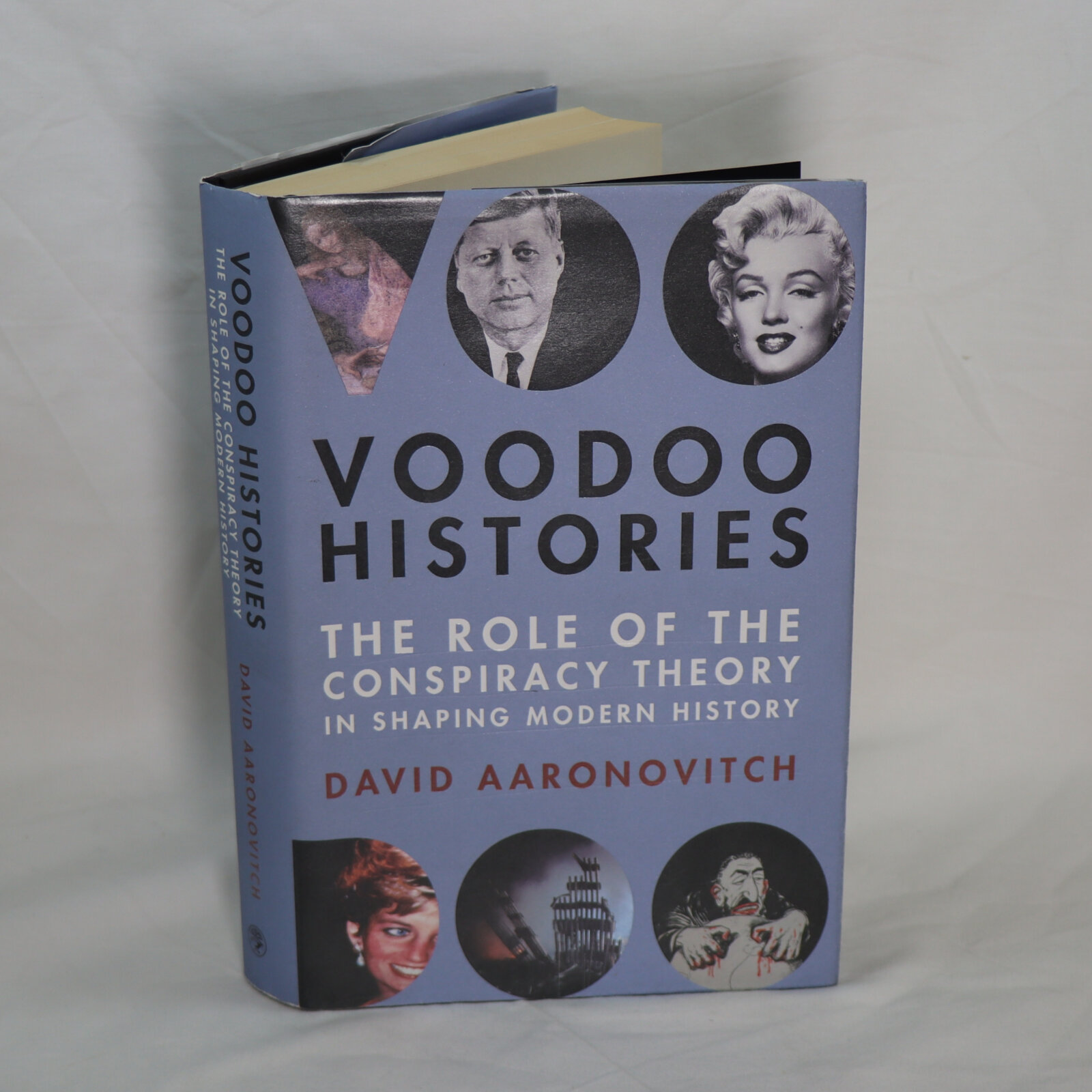
Related products
Share this Page with a friend


